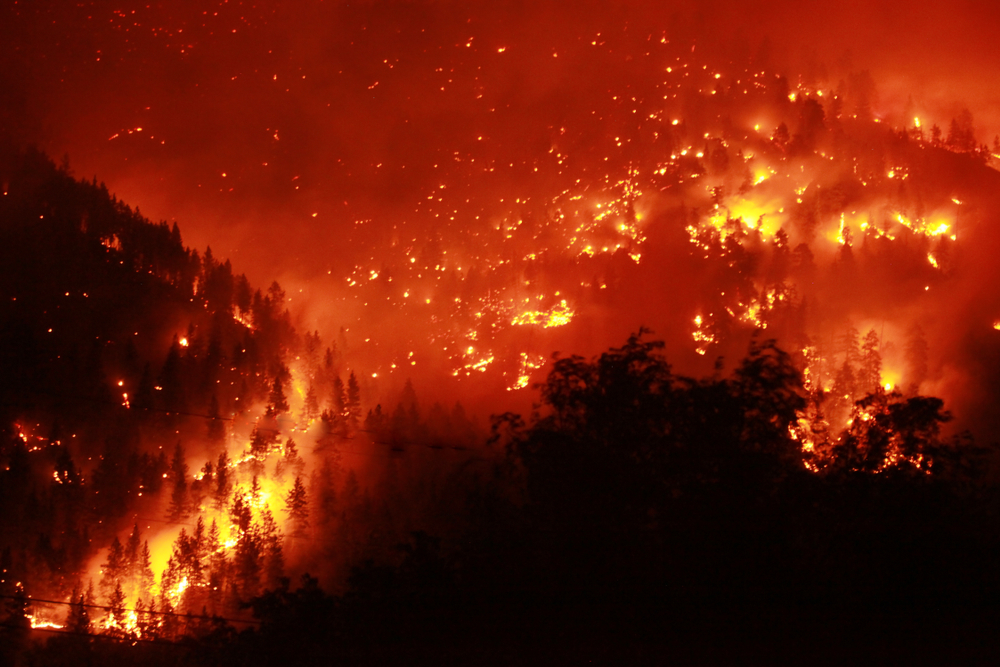Wildfire emissions surge: Unpacking the environmental implications
- August 4, 2023
- 9:59 am


Iain Hoey
Share this content
A devastating wildfire season leads to record-breaking emissions
Fires raging across the Canadian wilderness this year have unleashed 290 million tonnes of carbon.
This represents a twofold increase over any previous yearly record.
The wildfire emissions are expected to rise even further, given the fact that hundreds of blazes continue to seethe throughout the country, according to a recent report by the EU’s Copernicus Atmospheric Monitoring Service shared by Reuters.
This year’s fire emissions from Canada alone have contributed over 25% to the total global count for 2023 thus far.
These emissions notably surpass the prior Canadian record of 138 million tonnes, recorded in 2014, as reported by Copernicus.
Since the inception of satellite monitoring of wildfire emissions in 2003, this year’s wildfire season has been deemed the worst on record for area burned.
Wildfire emissions and their vast impact on global carbon levels
An alarming area of about 131,000 square kilometres has already been torched across eastern and western Canada.
That’s roughly equivalent to the size of Greece and exceeds the combined areas affected in the years 2016, 2019, 2020, and 2022, as indicated by the Canadian Interagency Forest Fire Centre.
This year, smoke emanating from the Canadian wildfires shrouded several major cities, including New York City and Toronto.
The smoggy conditions led public health authorities to issue air quality alerts.
The smoke from wildfires is associated with elevated incidences of heart attacks, strokes, and increased emergency room visits for respiratory ailments.
To date, almost all of Canada’s 13 provinces and territories have been impacted by wildfires.
As of Thursday, over 1,040 fires were recorded, with approximately 660 of them deemed uncontrollable.
The consequences of wildfire emissions and the continued monitoring
According to Mark Parrington, a senior scientist at Copernicus: “As fire emissions from boreal regions typically peak at the end of July and early August, the total is still likely to continue rising for some more weeks and we will continue to monitor.”
Forests serve as essential carbon sinks, helping to mitigate the effects of global warming.
Canada’s northern boreal forest, in particular, is estimated to store more than 200 billion tonnes of carbon.
This figure equates to several decades’ worth of global carbon emissions.
However, when forests burn, they release a portion of this carbon back into the atmosphere.
This process accelerates global warming and establishes a dangerous feedback loop, as it results in conditions that make forests more susceptible to fires.
Scientists express particular concern about the atmospheric and health impacts of Canada’s fires.
The carbon being released is roughly equivalent to Indonesia’s annual carbon dioxide emissions produced from burning fossil fuels.
IFSJ Comment
With wildfires becoming more frequent and intense, understanding their emissions and impacts on the atmosphere is paramount.
As one of the most significant carbon sinks globally, the health of Canada’s boreal forest has profound implications for global climate change.
This serves as a critical reminder of the need for effective strategies in forest management and wildfire prevention to protect these indispensable ecosystems and limit future carbon emissions.
Wildfire emissions explained
In recent years, the frequency and intensity of wildfires have significantly increased worldwide, largely attributed to climate change and human activities.
The International Panel on Climate Change confirms this trend.
However, one aspect that hasn’t been examined in detail until now is the environmental implications of wildfire emissions.
Wildfires generate a wide range of pollutants, including fine particulate matter (PM2.5), carbon monoxide (CO), and nitrogen oxides (NOx). These pollutants have significant implications for both human health and the environment.
The climate impact of wildfire emissions
The primary climate impact of wildfire emissions stems from the significant amount of carbon dioxide (CO2) released into the atmosphere. CO2 is a greenhouse gas that directly contributes to global warming.
The U.S. Environmental Protection Agency categorizes CO2 as the most crucial greenhouse gas emitted through human activities.
A less known but equally impactful pollutant from wildfires is black carbon.
When wildfires burn vegetation, they release large amounts of black carbon (also known as soot), a short-lived climate pollutant.
Black carbon absorbs sunlight and warms the atmosphere, contributing to climate change.
According to the European Environment Agency, black carbon is the second-largest contributor to global warming after CO2.
The health impact of wildfire emissions
Health impacts from wildfire emissions are significant and wide-ranging.
Fine particulate matter (PM2.5) generated from wildfires can penetrate the respiratory system, leading to heart and lung diseases, including stroke and asthma.
The World Health Organization has classified PM2.5 as a major health risk.
CO and NOx from wildfires can also lead to harmful health effects.
High CO levels can cause symptoms such as headaches, dizziness, and at extremely high levels, death.
The Centers for Disease Control and Prevention warns that people with chronic heart disease are particularly at risk.
Similarly, exposure to NOx can lead to respiratory problems and can also contribute to the formation of other harmful pollutants such as ground-level ozone.
The ecological impact of wildfire emissions
Wildfires’ ecological impacts are far-reaching. Besides the immediate destruction of habitats, wildfire emissions’ persistent impacts on ecosystems often get overlooked.
Persistent nitrogen deposition from NOx emissions can lead to changes in species composition and soil nutrient imbalances, negatively affecting biodiversity. Studies from the U.S. Geological Survey emphasize the growing importance of this aspect.
Wildfire emissions also lead to localized air pollution, resulting in acidic rain and contamination of water bodies, impacting aquatic life.
A study in the Proceedings of the National Academy of Sciences identified a correlation between wildfires and elevated mercury levels in nearby fish.
In conclusion, the surge in wildfire emissions is an environmental issue that deserves our urgent attention.
Efforts must be directed towards not just mitigating wildfires, but also understanding and addressing the multi-dimensional implications of wildfire emissions.
It is not just about saving the forests; it’s about preserving the planet for generations to come.

